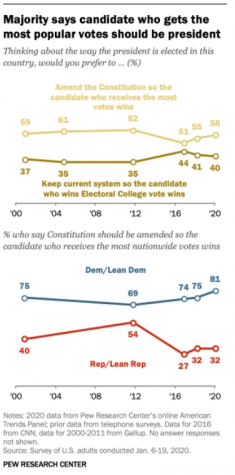The Inequality in the Electoral College
The electoral college inhibits all voters from being able to have equal say in the leaders of their nation.
PHOTO | TNS
LANSING, MI – DECEMBER 19: Jane Dailey, of Lansing, protests President-elect Donald Trump at a rally at the Michigan State Capitol before the state electoral college met to cast their votes on December 19, 2016 in Lansing, Michigan, United States. "I know it won't change anything but I had to do something," Dailey said. The electoral college met in the afternoon and voted unanimously for Trump. Electors from all 50 states cast votes today in their respective state capitols. (Photo by Sarah Rice/Getty Images)
When the electoral college was first established, its main purpose was to ensure that uneducated, lower-class citizens would not be able to completely control the election and qualified citizens would determine the President. In 2020 in America, ninety-percent of Americans over the age of 25 completed high school or more, according to the United States Census Bureau. In other words, Americans are more educated than ever, and therefore, an electoral college does not truly serve its original purpose and gives smaller states too much power for their low population.
Nah. People who live in cities that truly represent the diversity of America should set the course. The electoral college is outdated, and was there to preserve slavery. We need to move on. https://t.co/vRykoYcPle
— Jemele Hill (@jemelehill) March 18, 2019
In the past 20 years alone, two of the six elections have contradicted the popular vote. If the entire point of democracy and equal voting rights is to give the power to the people to choose their leader, the electoral college is failing the American people who have fought hard for their right to vote. It is hard to have faith in a system that only causes and allows misrepresentation of populations and skewed results in the end. The argument that the electoral college allows some states some smaller to have representation that they would not otherwise get is misguided. The purpose of voting is representation in the government and by voting, Americans ensure that their convictions are demonstrated by voting and it allows people, even those who are in a political minority in a state, to determine the nation’s leaders and policies.

The electoral college upholds a system that keeps control in the hands of the powerful and wealthy. The electoral college does not even get the popular vote with 58 percent of Americans wanting an amendment to the Constitution that would allow for the popular vote to determine the presidential elections, whereas 40 percent believe that the electoral college should continue as-is, according to Pew Research Center. In order for change to be enacted, younger generations will have to fight hard in order to create a government that represents the identity and values of America today. Luckily, this issue has started to resonate with younger people as they begin to vote in their first elections and see inequalities in the voting system they participate in.
The only real reason the electoral college still is around today is that the people who get to decide whether it should remain are the people who see the most benefit from the system. The powerful leaders get to keep their power by not questioning the system and not considering the opinions of common people. What worked 200 years ago does not necessarily work today, there’s a reason women don’t still wear corsets and there’s a reason that the electoral college should be abolished because times change and a democratic government should change with them. One electoral college vote in Wyoming represents 193,000 people but in Texas or California, one vote accounts for over 700,000 people, according to the United States State Department. There is no justification for this because it is simply not fair to all people.
We need to abolish the electoral college pic.twitter.com/sZqQs4xdyL
— ProgressivePower (@OurProgressive) December 1, 2020
Furthermore, the electoral college overcorrects the issue of small states’ underrepresentation and allows for certain people and states to get a larger voice in the most important election that has a considerable impact on the lives of so many. To continue to support the electoral college would be to support inequality, which is not something I intend to do ever and neither should the government.



